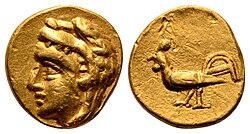
Back Dardania (Anatolia) Breton Dardanos (Stadt) German Δάρδανος (πόλη) Greek Dardania (Anatolia) Spanish Dardania (Troia) Basque Dardanie (Asie Mineure) French Dardania (Anatolia) Galician Dardania (Trója) Hungarian Dardania (Troas) ID Dardanos NB
∆άρδανος | |
 A stater of Dardanos showing the fighting bird on one side. | |
 Troas, showing the position of the city of Dardanus and the district of Dardania | |
| Coordinates | 40°05′07″N 26°22′07″E / 40.0852°N 26.3685°E |
|---|---|
Dardanus or Dardanum (Greek: Δάρδανος, Dardanos, the feminine form; Greek: Δάρδανον, Dardanon, the neuter) was an ancient city in the Troad.[1] It was sometimes called Dardania (Greek: Δαρδανία, Dardania, neuter plural of adjective Dardanios), a term used also for the district around it.[1] Pliny the Elder called it Dardanium (Latin neuter singular).[2] It appears in other sources indirectly as well. The city-ethnic, or appellation of a person from Dardanus, is Dardaneus (Greek: Δαρδανεύς). Its coin legends are DAR and DARDAN. Its localization is securely marked by an inscription naming itself on the site.
Its time as a classical polis, which it is called in numerous sources, is secured by inscriptional evidence. Its coins, of electrum, silver, and bronze, date from the 6th to the 4th centuries BC. They feature a "fighting cock" motif. Silver coins are in the Persian standard, suggesting that at some point Dardanus was under Persian rule, which it must have been, as the Persians controlled the region from time to time. One coin refers to Zenis Dardaneus, "satrap of Aeolis in 399," suggesting that by then the population was Aeolian.
During the 5th century BC, Dardanus was in the Delian League; that is, a member of the Athenian Empire. It is recorded on the tribute list from 451/50 through 429/9 BC as paying a cash tribute of 1 talent.[3]
- ^ a b "Dardanus" in William Smith, Dictionary of Greek and Roman Geography (1854)
- ^ Pliny the Elder, Natural History, 5.33
- ^ Mitchell, Stephen (2004). "Troad". An Inventory of Archaic and Classical Poleis. Oxford: Oxford U. Press. p. 1006.
© MMXXIII Rich X Search. We shall prevail. All rights reserved. Rich X Search